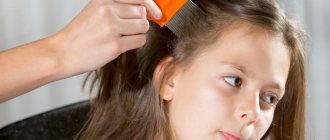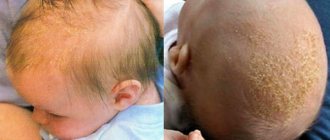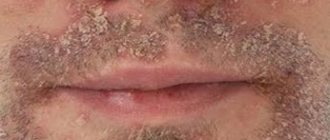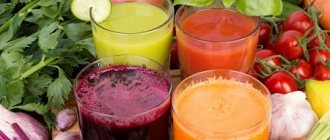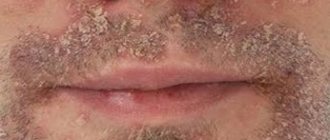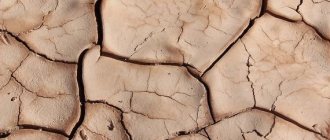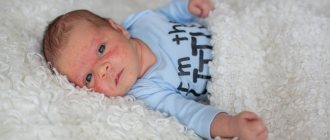05/27/2021 Reading time: 5 min 15993 0
By the end of the first month of life or a little later, yellowish crusty scales can be noticed on the baby’s scalp. They can frighten and upset a mother who is unprepared for such a phenomenon, but meanwhile there is nothing terrible about them. Milk crusts, which actually have nothing to do with milk, occur in many children under one year old. In medical terminology, they are called seborrheic dermatitis, physiological seborrhea or gneiss.
Yellow crusts, milky crusts in a newborn. Why are they formed?
Yellow crusts on the baby's head are formed due to age-related characteristics of the sebaceous glands. There are many of them on the head, and under the influence of maternal hormones, these glands actively produce a secretion - sebum. Drying together with exfoliated pieces of the epidermis - the upper layer of the skin - it forms unsightly yellowish crusts. Also, the formation of crusts can be influenced by Malassezia fungi, which live on human skin and feed on the secretions of the sebaceous glands. Since the secretion is produced in excess, the colonies of the fungus grow and there are more crusts. Sometimes they say that the cause of seborrheic dermatitis in infants is poor care or improper nutrition of the nursing mother, but this is a wrong opinion. True, the crusts can actually become larger if the baby’s room is hot and dry, if he is constantly wearing a cap or cap.
Mom needs to keep in mind that seborrheic dermatitis can appear not only on the child’s head, but also on other areas of the skin where the sebaceous glands are active: on the forehead, nose and chin, behind the ears, in the navel area and in the folds. Should they be removed? Milk crusts are a temporary age-related phenomenon. As a rule, by the age of one year they go away on their own. If there are no layers of crusts on the child’s head and the skin underneath is not inflamed, then it is not necessary to remove them. But do you have the patience to look at the ugly yellow formations on the skin of your wonderful baby and do nothing?
It is important!
My hands are just reaching out to pick it up a little, to remove this disgrace.
However, this should never be done! This can damage the baby's delicate skin and cause infection. Instead of the desired beauty, you will get health problems for the baby. If you decide to rid your baby of seborrheic dermatitis, do it in a safe way.
Prevention of skin disease
In order for the birth of a baby to bring joy, and not endless worries about his health, you should take preventive measures seriously:
- During pregnancy, it is very important to avoid stressful situations, lead an active, healthy lifestyle, and follow a diet that contains foods containing vitamins and beneficial microelements for the normal development of the unborn child.
- Maintaining child body hygiene.
- Water procedures should be carried out only using products with a hypoallergenic effect.
- Keep the baby's head open indoors. When walking, do not wrap yourself up excessively to prevent overheating of the skin.
How to choose a shampoo and will it help?
The easiest way to get rid of crusts is to apply baby shampoo to your baby's scalp and leave it on for 5-10 minutes while bathing. The crusts will become softer. Some of them will be washed off during rinsing, some will come off when you dry the child’s head with a towel, the rest will need to be carefully combed out with a soft brush or a comb with rounded teeth at the ends. If there are few crusts, then one or two such procedures will be enough. If there is a lot, then more.
To combat crusts, any baby shampoo approved for use from the first days of a child’s life is suitable. But if you wish, you can purchase a special shampoo for milk crusts. Will it be more effective than regular? Read the reviews. For some it helps immediately, for others it doesn’t help at all. If the baby has a lot of crusts and layers, then most likely the shampoo will not give a quick effect. Other remedies for crusts To combat profuse manifestations of seborrheic dermatitis, oil products are suitable: children's cosmetic oil, special oil gel against crusts, emollient cream. Half an hour to an hour before bathing, smear the child’s head with this product and put a hat on him. While bathing, wash your baby's hair with baby shampoo, and then comb it with a soft brush or blunt-tooth comb.
It is important!
One procedure may not be enough. After a few days, if necessary, it can be repeated. Do not overdo it. Using shampoo every day will dry out your baby's scalp and make his sebaceous glands work even harder. That is, the effect will be the opposite: there will only be more crusts.
If you notice that under the scabs your baby’s skin is red, begins to get wet, and bleeds, consult a doctor. It is also worth showing your baby to the doctor if crusts cover not only his head, but also his face, neck, and groin.
So:
- Crusts on the baby’s head are formed due to the intense secretion of sebum under the influence of maternal hormones, as well as due to the activity of Malassezia fungi, which are present on the skin of every person.
- It is not necessary to remove milk crusts, but they will take a long time to disappear.
- You can choose any shampoo to combat milk crusts, the main thing is that it is approved for use from the first days of life. The use of a special shampoo against milk crusts does not guarantee a complete and quick effect.
- You can remove milk crusts using baby oil. To do this, you need to apply it under your cap an hour before bathing, and then rinse with shampoo and carefully comb out the crusts with a soft brush.
- If these remedies do not help, and crusts appear not only on the head, but also on the child’s face and body, consult a doctor.
(1 ratings; article rating 5.0)
Share Share Share
Traditional healers recommend
Nature gives us many useful plants with which we can get rid of seborrheic dermatitis. However, any use of folk remedies is advisable only after consultation with a doctor, especially if it concerns the health of a child.
Infusion on the roots
Mix burdock roots, elecampane (15 g each), and several St. John's wort inflorescences. One tablespoon of the collection is poured into 250 g of boiling water and infused in a thermos for about 8 hours. Then the strained infusion is rubbed into painful areas after bathing.
Miracle Sage
For one glass of water, take 20 g of dried sage leaves, boil all this for 15 minutes. Allow to cool and apply as a lotion to areas affected by gneiss.
Oak bark will cleanse your skin
Keep a container with one glass of boiling water and 25 g of oak bark in a water bath for 5 minutes. After three hours of infusion, pass through the filter and rub into painful areas of the skin.
Flower medicine
One tablespoon of chamomile, calendula and crushed plantain leaves (in equal parts) is placed in a thermos and filled with boiling water (1.5 cups). It is infused for three hours, then the areas affected by seborrheic dermatitis are wiped with a gauze swab.
Before using folk remedies, it is essential to consult a doctor who will advise testing for individual tolerance to a particular folk remedy. To do this, just moisten the prepared infusion with a tampon and attach it to the baby’s wrist. After 24 hours, check the condition of the skin. If there is no redness, then this folk medicine is suitable for use.
Judging by the reviews of those who have used such home remedies, they can indeed have a positive effect, but you need to make the right choice in consultation with your doctor.
More information about the use of alternative medicine can be found in forums where those interested in curing seborrhea in newborns communicate. Here you can find reviews and different opinions that help you make the right decision.
Useful tips for parents
A nursing mother should strictly monitor her diet. It is necessary to reduce fatty foods, whole milk and fermented milk products with a high percentage of fat to a minimum. Do not get carried away with baked goods, sweets, and other dishes containing high levels of carbohydrates.
When feeding with ready-made formulas, you should not skimp on the baby’s health and do not buy cheap ones without the “hypoallergenic” sign.
To reduce the amount of time you bathe your baby using shampoo or soap, change diapers more often. Do not overuse wearing extra blouses and caps, so as not to cause increased sweating and not provoke the appearance of such an unpleasant pathology of the epidermis.
Share with friends
Rate this article
Gneiss treatment forecasts
If the nature of the occurrence of seborrhea on the baby’s head and other parts of the body is physiological in nature, the prognosis is comforting. The disease goes away naturally without drug treatment. As noted above, it is enough to follow the recommendations for creating an appropriate environment and caring for the baby.
There is significantly less optimism in expectations of recovery in congenital seborrheic dermatitis. In such cases, it is quite difficult to achieve positive results. It is very difficult to correct an inherited genetic predisposition to such a disease. It will not be possible to completely get rid of it; the main thing is to prevent a severe form. To do this, periodically contact a dermatologist.
Clinical researches
La-Cri foam shampoo for children is created specifically to cleanse the baby’s delicate skin and hair. The product is recommended by the Union of Pediatricians of Russia. A clinical study conducted jointly with the Union of Pediatricians of Russia proves the high efficiency, safety and tolerability of products for daily skin care of children with mild and moderate forms of atopic dermatitis and during remission, accompanied by a decrease in the quality of life of patients.
Sources:
- Kildiyarova Rita Rafgatovna, Pediatrician for every day. Guide for doctors, GEOTAR-Media, 2022.
- Anderson, Arici, Azzopardi, Visual neonatology. Guide, GEOTAR-Media, 2022.
- Mancini A.J., Krouchuk D.P., Pediatric dermatology. Practical medicine, Directory, 2022.
Photos of dermatitis
Photo album on the diseaseHow to remove crusts from a child's head?
In order for seborrheic scales to quickly disappear from the baby’s head, it is necessary to properly care for the baby’s skin:
- Do not rip off or scratch the golden-yellow crusts under any circumstances. This is painful and can cause injury to the delicate epidermis. In addition, under the greasy flakes, inflamed, red areas may open up and are easily accessible to infection.
- When bathing your baby, carefully wash his hair with a special detergent that has passed appropriate tests and does not contain alkalis, dyes or prohibited ingredients. For example, baby shampoo for sensitive skin “ Ushasty Nyan ” with extracts of celandine and viburnum produced by JSC “Nevskaya Kosmetika”, which:
- gently cleanses both hair and skin;
- suitable for washing hair with areas of redness, irritation, and peeling;
- ideal for babies with particularly sensitive epidermis;
- creates lush foam and does not sting the eyes;
- has a natural pH level;
- makes the child's hair shiny and manageable for combing;
- moisturizes and softens delicate baby skin;
- maintains water-fat skin balance.
- Immediately after water procedures, very carefully remove (comb out with a blunt-toothed comb) loose, soaked scales. Those that have not moved away should not be touched.
Important: The fontanelle is the most sensitive place on a baby’s head. And the skin here needs cleanliness and natural ventilation. Therefore, gneiss from the fontanel must be removed. But this must be done extremely carefully.

